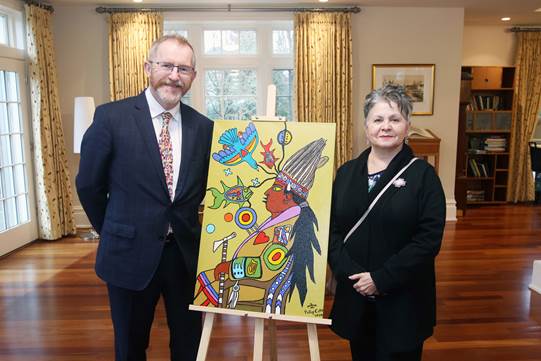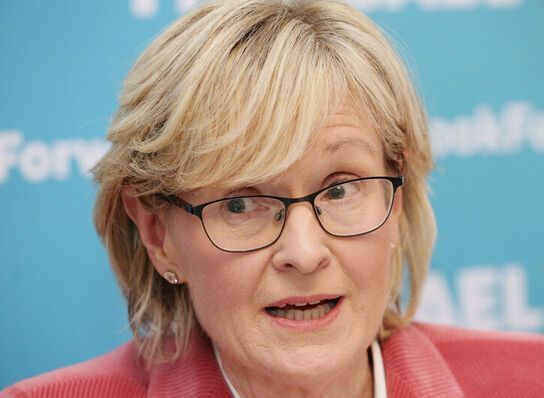Ireland’s Ambassador to Canada, Dr. Eamonn McKee, recently launched the Honouring Indigenous Aid program at the Irish Residence in Ottawa.
He paid tribute to First Nations in Canada West (now Ontario) that contributed to Irish Famine relief in 1847. Their compassion and generosity were brought to light in recently discovered archival records.
“I want to begin by formally thanking the representatives of the Anishinaabe, Haudenosaunee and Wendat nations who gave us aid in the worst year of the long history of the Irish, 1847,” Ambassador McKee declared.
“They saw our refugees arrive on these shores and river banks, stricken and starving. They collected money to send to Ireland. That act of compassion, of agency in the face a catastrophe that had befallen another people, shines out from the pages of history.”
“That page in our shared history would have remained closed were it not for the story keepers and on this occasion the story finders,” he added.
“I want to acknowledge Jason King, historian at the National Famine Museum and Irish Heritage Trust and Professor Mark McGowan for not only finding this story but for promoting it. Their efforts have shone a light on this page of history and led to this event and other events of gratitude and commemoration for the historic support of our Indigenous friends.”
“In gratitude and commemoration, we are planting a copse of River Birch here at the Irish Residence,” Ambassador McKee continued.
“We could not think of a more appropriate symbol of thanks for this occasion. It is a native species, one used often to sustain Indigenous life, like the birch bark and resin used to make the emblematic canoe.”
Claudette Commanda, an Anishinaabe Elder and Chancellor of the University of Ottawa, and Professor Mark McGowan from the University of St. Michael’s College in the University of Toronto also spoke at the ceremony.
Professor McGowan described the letters offering aid from Indigenous peoples in Canada West.
“The letters from Anishinaabeg peoples bore the interesting totem or doodem of the individual clans that had signed,” he remarked.
“The doodem had a deep meaning in Anishinaabeg law. When the figures of a crane, or a caribou, or a serpent, or an elk, or an eagle appear, these are rich symbols not of an individual but of a belonging and a relationship with a clan, and also a relationship with the land”.
He added: “The use of the doodem really is symbolic of a people signing this agreement to make this donation. It signifies the way in which the Anishinaabeg people may have seen this act of generosity as part of their treaty responsibility, because their treaties with the Crown would also have been signed with doodemag, the various totems.”
The tree planting ceremony was followed by the unveiling of a painting by the renowned Indigenous artist Philip Cote entitled "Sacred Feathers." It captures the moment that the Mississaugas of the Credit chief Peter Jones (also known as Kahkewaquonaby, or Sacred Feathers) commits his people to contributing to Irish Famine relief in 1847.
It was an extraordinary act of generosity as they were in the process of being removed from their home without knowing where they would resettle. The painting is composed in the Anishinaabe Woodlands Style, which blends traditional legends and myths with contemporary mediums and subtle Irish motifs.
Indigenous people from a number of First Nations in Ontario and Quebec attended the ceremony. Cheyenne Lazore from the Mohawk Nation at Akwesasne brought with her a ribbon skirt with Irish symbols that she had created to honour Ireland Lacrosse for ceding its place so that the Iroquois Nationals could play in the 2022 World Games.
“It is my belief that my ancestors’ contributions through aid for the Irish Famine in 1847 inspired Team Ireland to reciprocate as an act of generosity, as an act of kindred spirits towards the Haudenosaunee people,” she said. “The ribbon skirt is worn by Indigenous people for special occasions, for ceremony, and in this case it was a way to say thank you to Team Ireland”.
One of the ceremony’s most poignant moments occurred when Nathan Brinklow (Thanyehténhas, Director, Indigenous Studies, Queen’s University) read the Famine relief letter from his ancestors at Tyendinaga Mohawk Territory (April 17, 1847) which he translated from English back into Kanien'kéha, the original Mohawk language.
“We took our thoughts and our sympathies in one language and we packaged them up into another to send them across an ocean to be translated into another language [Gaelic], both of us communicating in the language of our colonizer,” he said.
“One of the things I wanted to do was to translate the letter, to re-voice the letter into a form to give my ancestors back the words that they might have said had they been able to use their own language.”
The Honouring Indigenous Aid program of events and film releases continues until June 2024. It is hosted by the National Famine Museum, Strokestown Park and Irish Heritage Trust in collaboration with the Embassy of Ireland in Ottawa and the University of St. Michael’s College in the University of Toronto. The Government of Ireland Emigrant Support Programme funds it.
You can watch the Honouring Indigenous Aid short film at: https://youtu.be/tamUj-omKnw









